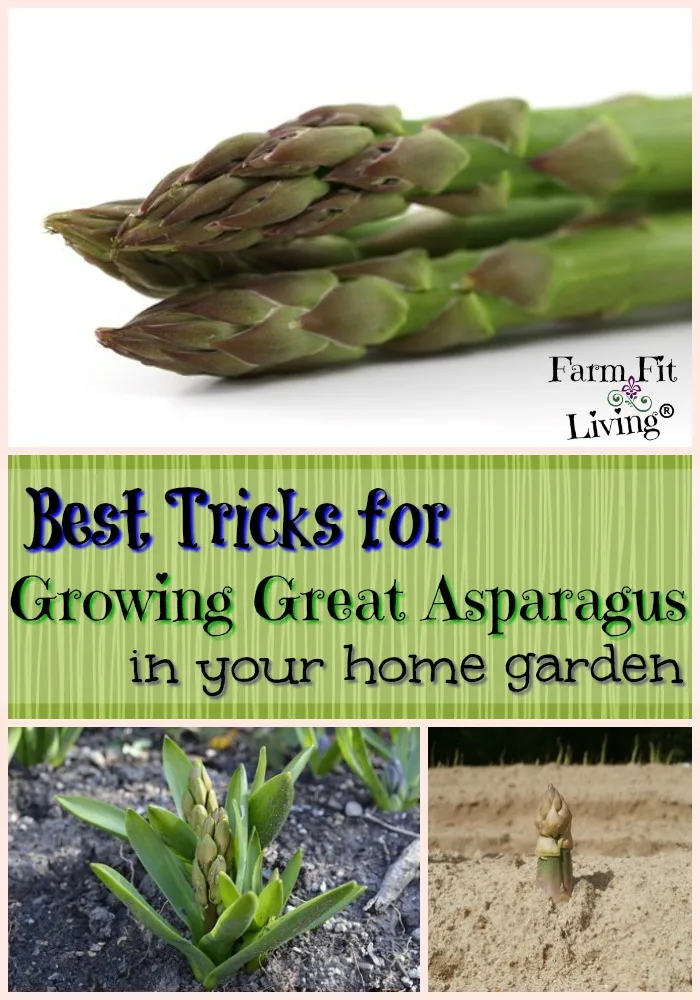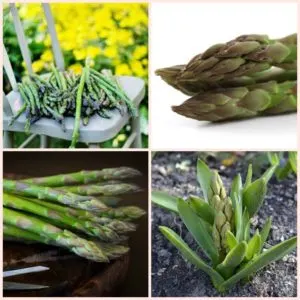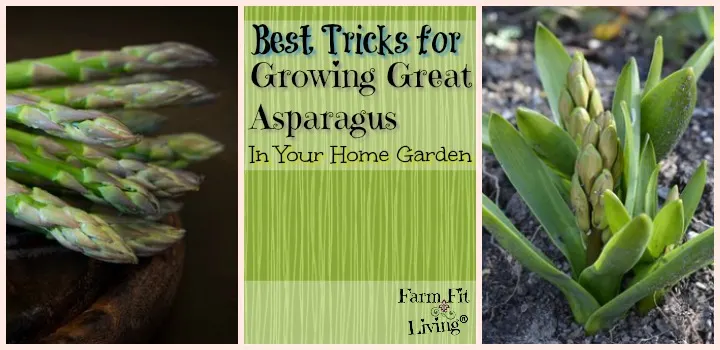Looking for tricks for growing great asparagus for your dinner (or breakfast) table?
Tricks for growing great asparagus will help you grow so much asparagus, you can eat it for every meal. It’s true. I love eating asparagus for breakfast. I cut it up and mix it in with cheesy scrambled farm fresh eggs. It’s one of my most favorite parts of spring/early summer.
Yes, Asparagus is best before the weather gets hot. That’s the first trick you must learn when growing fresh asparagus. So, it’s one of the very first veggies you’re going to get. This makes it extra special.
It’s also amazingly nutritious. It’s an excellent source of vitamin A, calcium, phosphorus, riboflavin and vitamin C. And you can’t get any better than fresh asparagus. The good news is that asparagus is pretty easy to grow.
And in this post, I’m going to give you:
- Info for how to grow asparagus effectively in your home garden
- The Best tricks for growing great asparagus
- Some easy asparagus recipes for preserving and eating this fresh nutritious veggie.
Listen to the Podcast Episode:
Early Planning for Asparagus
The first thing you need to know and appreciate about asparagus is that your patch will be in the same location many years. Asparagus continues to come up over and over again year after year.
So, it’s really important to prepare the soil of your expected patch thoroughly before you even begin planting. This starts the fall season before and applying plenty of organic matter on the patch spot. Some examples of organic matter include livestock manure, rotted sawdust or compost. I’ll give more thorough fertilizing recommendations later on in the post, so stay tuned.
When to plant new asparagus? A good time to plant crowns in my area of Kansas is between March 15 to April 15 or when the soil temperature hits 50 degrees. That soil temperature is super important.
Next, asparagus placement in your garden is important. Asparagus makes an attractive screen to enclose a garden. The tops grow 4 to 6 feet tall and act as a windbreak during summer months. One can mow up close to the plants, and grass from a lawn acts as a mulch and helps prevent
weed growth.
For further reading on garden planning, go here
What varieties to plant?
Wherever you are in the world, it’s important to plant varieties that are well adapted to your area. Characteristics of really good varieties are dark green, rust resistant, vigorous and of high quality.
There are green varieties but also white varieties. It all depends on what you like and what grows well. To find out what these varieties are for your area, contact your local Extension service or Agriculture Service. Or just ask other home gardeners near you.
Great varieties that work well for my area of Northeast Kansas include:
- UC157
- Jersey Giant
- Ida Lea
- Jersey Knight
- Jersey General
Keep in mind that there are no actual Genetically Modified (GMO) Asparagus varieties on the market at this time. All asparagus is GMO free. If you’re looking for that labeling on your crowns or even on asparagus you find, you won’t find it. Or at least…you shouldn’t find it.
For other correct facts about agriculture, go here.
How to grow new asparagus from seed
This is a common question asked, but the answer is that it takes an additional year to produce a productive crown. So, if you’re wanting asparagus sooner than later, you’ll want to buy crowns instead.
But if you’re a homesteader or business owner wishing to grow your own crowns, go for it. It’s totally possible.
You can also purchase or grow seedling transplants to set in mid-spring. Keep in mind that transplants need to be 8 to 10 weeks old before transplanting. To start asparagus from seed, keep in mind the germination temperature needed to start asparagus. Asparagus needs a soil temperature of at least 50 degrees when starting it.
For more info on soil temperature, go here.
How to grow asparagus the easier way
There’s an easier way. It’s called purchasing 1-year-old crowns or roots from a garden dealer, seed supplier or nursery. Or order from Amazon as I have linked to above. These crowns will be ready to start producing in the same year.
Here’s the specifics on planting crowns:
- Dig a trench 8-9 inches deep.
- Place crowns at the bottom.
- Crown spacing should be 18-24 inches apart.
- Row Spacing should be 4-5 feet apart if planting a lot of rows.
- Initially cover the crowns with 2 to 3 inches of soil and pack it well around the crowns.
- DON’T fill in the entire trench but DO gradually add soil to fill the trench as the plant grows.
That last tricks for growing great asparagus in that bullet section is for weed control. Gradually adding in soil will cover small weeds and kills them. Eventually, the entire trench will be filled up with soil.
Fertilizing Asparagus
To clarify, asparagus should be fertilized for great asparagus. There is organic and conventional methods for fertilizing asparagus that you should be aware of.
What is the best fertilizer for asparagus? Here’s a great organic fertilizer option for asparagus.
Now, let’s talk about how to fertilize asparagus.
The fertilizer should be applied in the fall even before planting in the spring. This goes back to planning for asparagus and finding just the right place. Remember that your asparagus patch will be established for years.
So, in the fall, add 8 to 10 pounds of the 5-10-5 fertilizer per 1,000 square feet of garden area. This is a recommendation from Kansas State University horticulture, a service I use regularly for soil testing and fertilizer recommendations. If you have a generous amount of organic matter applied, only use half as much of the 5-10-5 fertilizer.
Then, in the spring, it is recommended to apply 4-5 pounds of the 5-10-5 fertilizer per 1,000 square feet. Apply the fertilizer early in the spring before any spears emerge and work it into the ground
Finally, the last round of recommended fertilizer is nitrogen and should be applied after harvest. In my area, this is done late into the month of June. Since the weather is hotter now, be sure to apply this before a rainfall or water it in well to make sure it releases into the soil and not into the air. The recommended amount here is 1 pound of nitrogen per 1,000 square feet.
Care of a New or Established Planting
Now that your crowns are in the ground and fertilized, you’ll see them starting to come up in the early spring. Here’s some more care tips and tricks for growing great asparagus for years.
The first is weed control. Of course, weeds can be controlled with hoes, cultivators and tillers, but you can also use chemicals to control weeds as well. If using a chemical, apply to weed-free soil before and after the cutting seasons. A second application can be applied later if weeds become a problem. If you use a chemical, please follow labels to a tee.
The second trick is to letting the tops grow on the plants through the first two seasons until after killing freezes. This is because the tops are essential in producing and transferring food to the roots for next spring’s crop. It also helps keep the plants sturdy through a windy winter and also acts as a snow barrier.
Your plants may get tall from so much good care you’re giving them. To keep the plants from falling over, set posts 10 to 12 feet apart and pull the plants up straight with wire or cord tied to the posts.
Lastly, wildlife control methods is needed. Deer is the wildlife species mostly affecting asparagus.
Here are some good ideas to retract deer from your garden.
Harvesting Asparagus for Easy Asparagus Recipes
Spear growth highly depends on temperature. The mercy or the wrath of Mother Nature.
And harvest depends on the growth of the plant as well as the variety of asparagus you’re growing. Again, food reserves transported to the roots during the previous season promotes the growth of asparagus. Therefore, more than likely, asparagus shoots won’t be ready for harvested in the first year from crowns.
Furthermore, you may have to limit harvest the next year 3-4 weeks or until spear size decreases in diameter. But, in the third season, your patience will pay off and your asparagus shoots will be large enough and healthy enough to be harvested regularly for 6-8 weeks.
The rule of thumb is to harvest young, tender spears from 5-10 inches long. The warmer the temperature, the quicker the asparagus will regrow. If just warm normal spring temperatures, asparagus may only need to be harvested every three days. But if the weather is hotter than normal or going into summer, harvest may need to happen every day.
What does the asparagus look like when it’s ready to harvest?
The tips of the spears should stay tight and a nice size. If the spears become too large, cut them and discard them. This will allow new spears to come on in their place.
To harvest asparagus for easy asparagus recipes, cut the spears or shoots. Cut them about 1 to 2 inches below the soil surface – I’ve linked up to a good tool below to help with this. You can also cut or snap the spears at the soil surface using a sharp garden knife. Be sure to cut only the spear you want to harvest. Take care not to damage other young spears just under the soil surface.
A well tended 1,000 square feet asparagus patch can yield 80-100 pounds. This may seem large, but it’s easy to do the math and break it down to the size of your own patch so you can get an idea of how much you’ll be growing.
Asparagus Problems You Might Face
Like any other thing grown or produced, asparagus presents it’s own varieties of problems. I’m going to briefly cover some of these problems now and hopefully give you some solutions.
The first is asparagus rust. Rust first appears as small, reddish-brown spots on stems. It may spread and cause leaves of young shoots to die and fall off. New strains of asparagus are available that resist rust. In other varieties, rust can be controlled with fungicide spray applied after the
harvest season.
The second problem is an insect: Asparagus beetle—Beetles (1⁄4 inch long) have a red thorax and blue wing covers with yellow spots. Larvae and adults eat stems and leaves. Conspicuous dark eggs are laid on stems. It’s usually two to four generations per year and usually a problem in spring on new stems.
Some other possible problems—Several other insect and disease problems occasionally may attack asparagus plantings. Your local county agent can assist in diagnosing problems that develop and can recommend proper control measures.
Good care of weeds and the shoots can help prevent most of these problems.
Super Easy Asparagus Recipes
Asparagus can then be trimmed and washed for eating. Since it grows above the ground, it’s very easy to clean. I usually just rinse it. It can be prepared fresh or it may be canned or frozen.
We love to eat asparagus in a number of ways. I’ve already mentioned slicing it and mixing it into scrambled eggs with cheese.
Grilling it is another option. Here’s my recipe for grilled asparagus.
It’s also very delicious simply boiled and topped again with cheese. I grew up eating a ton of asparagus this way. I prefer it to be a little on the crunchy side so be sure not to cook it for too long. Season as desired.
Finally, asparagus can be canned and frozen for later enjoyment.
Are you comfortable with how to grow asparagus?
I hope I’ve listed out the best practices and tricks for growing great asparagus. What are your best tips for how to grow asparagus. Is there something I missed? Go ahead and leave it in the comments!
Also, if you have easy asparagus recipes you’d love to share, comment below. I’d love to know how you enjoy fresh asparagus.
Thanks for reading. Hopefully you learned the best tricks for growing great asparagus and you’re ready to get out there and start planning for your patch.


Make Gardening Simple Now!

Simple gardening equals smart gardening. In this short, easy to read book, you'll get access to all the best practices and tips for gardening smarter and more successfully. If you want more information, I'll send it right to your email inbox!





Gwen
Tuesday 5th of June 2018
Thank you for this helpful article. I’m wondering, from each crown in the growing season, how many stalks should you let mature into full grown plants? We are in our 4th year and we let 1 mature for each crown and harvest the rest. I feel as though our harvest for our 4 crowns is low. We get about 4 shoots per day. Thanks in advance.
Mindy Young
Wednesday 6th of June 2018
Hi, Gwen! We do usually let several stalks mature from each crown. I'd say about 4 or 5 per crown. By the end of the season, these are going to look less appealing anyways and that's when we know the season end is near. This year, it was very hot very early, so our season was cut short. We only had asparagus for a few weeks before we let it go. Hope this helps.